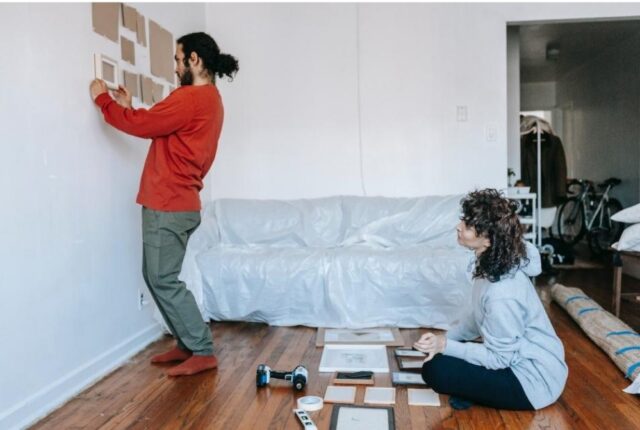
Moving in together with a partner is a wonderful occasion that can change your entire life trajectory. However, if you’re like most couples, this step will also bring you face-to-face with all your differences. You’ll start to notice daily habits that you may not have noticed before, or you may find out something new about their personality. After all, even if you may believe they are a perfect partner, chances are they will have different views on certain aspects. And the biggest and most prominent difference you will notice is the difference in your design choices. In order to create a space you both will feel proud to call home, here are some tips on how to combine your tastes and styles.
Establish ground rules
The first step to improving your relationship and also combining your lives together is managing your expectations. You should vow to keep things civil and to compromise whenever possible. Furthermore, you must agree that you’ll both work hard in creating your future space. You should also discuss the many demands and desires you might have for residing together. Perhaps you want to create a comfortable reading area while your partner wants their own workspace. Whatever your different needs and wants may be, establish ground rules that you and your partner must adhere to in order to design your home.
Get to know each other’s tastes and styles
After you’ve both agreed on what you expect from this new step in your lives, it is time to get to know each other’s tastes and styles. This is key if you want to create a blend of both of your tastes and styles while keeping both of you happy. There are different ways you may accomplish this. If you or your partner struggle to find words to describe your tastes, flip through magazines or go furniture browsing and point out different things you may like or not like. When discussing such preferences, pay close attention to things you agree on and try and remember them so you may incorporate this common ground into your design style.

Practice mindful communication
When discussing your various tastes, styles, needs, and wants, there will come a time you will disagree. This is to be expected. However, the way you respond to such differences is the most important. You must practice mindful communication where you clearly state what you dislike without insulting your partner. For example, you may not like the sofa he wants to bring into your space. Instead of saying: “It’s ugly, I hate it”, you may say things like “I do not think it fits the style of our home. I believe it is too worn down. I think it is too large for our space”. Be precise about what you dislike about it and be open to talking it through. Constructive communication is key to keeping things civil and understanding each other’s perspective.
Do a general declutter
The dreaded decluttering will create the space needed for blending both of your styles and tastes. This is why professional movers such as State to State Move often talk about the importance of decluttering. Look through your various nick-nacks and decide what you would wish to keep and what you do not need anymore. When doing this, keep in mind how much you expect your partner to purge and follow this principle yourself as well. Try and understand there is a difference between your must-haves and things you simply wish to keep. Furthermore, when decluttering, decide what you will do with duplicates. If both of you have, for example, a bed, you may decide which one to keep based on the size, condition, and quality.

Go shopping together
A true way you can combine your tastes and styles is by purchasing different items together. You can even make it into a fun date idea! And once you acquire items you both like, this will make each of you feel like you had a say in designing your new home. Furthermore, it will help you understand your common ground and, additionally, take full advantage of it. However, be sure to discuss the budget beforehand and what exactly you wish to add to your shared space. This will ensure you both understand the task ahead.
Be prepared to compromise
Disagreeing about things you want in your home is normal, as stated before. Therefore, be prepared to not only be mindful when communicating but also to compromise. Sometimes it is impossible to find an item you both like, in such a case, you must decide if you are willing to compromise and give in to your partner’s request. Furthermore, you can pick different elements you like and elements your partner likes and incorporate them in different rooms. Another way you can compromise is by giving your partner full design control of one specific room. For example, you can decorate your bedroom while your partner focuses on the kitchen. Make sure, however, that you are truly compromising and that such a choice will not harbor any resentment in you.

Tips on blending styles without creating a mismatched chaos
Homes with different layers of design can be exciting and engaging. However, too much of that and you risk creating an unbalanced space you will not wish to spend any time in. So, how do you combine your tastes and styles while creating a beautiful home?
- Pick a color scheme you can stick to: This can be a difficult task, but you and your partner should discuss the color schemes you want to go for. Maybe you want to have a warmer kitchen and cooler bathroom. Discuss specific hues you want to add and create a balanced color scheme for your home and each room individually.
- Mix and match different styles strategically: Do not make one room mid-century modern and the other traditional. Instead, combine different elements of each design style so you can create a seamless blend of them instead of a clear-cut line between these two rooms.
- Combine different pieces of furniture and decor with similar-looking ones: Even if they may have a different color or theme, different pieces of furniture and decor can sometimes work together. To test this, place these items next to each other and judge for yourself.
- Go neutral if all goes wrong: If you cannot agree on the way you want to combine your tastes and styles, the last resort is starting fresh and choosing a neutral color scheme. Yes, it may not be the most engaging color scheme of all, but it will act as a middle ground for you and your partner.









